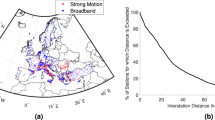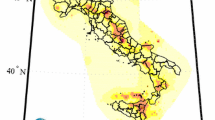Abstract
Critical slowing down-based early warning signals (EWSs) are well-known indicators that precede an approaching collapse in complex systems. To date, the majority of studies on the predictability of critical transitions consider systems perturbed with temporally uncorrelated noise. In contrast, here we study catastrophic and non-catastrophic transitions, and the performance of associated EWSs in systems perturbed with correlated noise. We find that elevated noise correlation can advance the occurrence of a catastrophic transition, and simultaneously progresses the system’s recovery. However, noise correlation does not have a significant impact on the likelihood of non-catastrophic transitions. We show that depending upon the transition mechanism, the occurrence of weak to false signals increases with noise reddening. Imperfect data sampling, both spatial and temporal, further reduces the efficacy of EWSs. Spatially limited data has more impact on the efficacy of EWSs for negative noise correlation than that of positive. However, temporally imperfect data is more detrimental for positively correlated noise. Overall, our study suggests that performance of EWSs is critical to system-specific perturbations as well as data sampling.







Similar content being viewed by others
Availability of data and material
This study does not include any data.
Code availability
Available at: https://github.com/T-kaur/NOISE_CORR_EWS
References
Bathiany S, Van der Bolt B, Williamson MS, Lenton TM, Scheffer M, van Nes EH, Notz D (2016) Statistical indicators of arctic sea-ice stability-prospects and limitations. The Cryosphere 10:1631–1645
Boerlijst MC, Oudman T, de Roos AM (2013) Catastrophic collapse can occur without early warning: examples of silent catastrophes in structured ecological models. PLoS One 8(4):e62033
Boettiger C (2018) From noise to knowledge: how randomness generates novel phenomena and reveals information. Ecol Lett 21(8):1255–1267
Boettiger C, Ross N, Hastings A (2013) Early warning signals: the charted and uncharted territories. Theor Ecol 6:255–264
Boulton CA, Lenton TM (2015) Slowing down of North Pacific climate variability and its implications for abrupt ecosystem change. Proc Natl Acad Sci 112(37):11496–11501
Boulton CA, Lenton TM (2019) A new method for detecting abrupt shifts in time series. F1000Research 8(746):746
Brett TS, O’Dea EB, Marty É, Miller PB, Park AW, Drake JM, Rohani P (2018) Anticipating epidemic transitions with imperfect data. PLoS Comput Biol 14(6):e1006204
Carpenter SR, Brock WA (2006) Rising variance: a leading indicator of ecological transition. Ecol Lett 9:311–318
Carpenter SR, Cole JJ, Pace ML, Batt R, Brock WA, Cline T, Coloso J, Hodgson JR, Kitchell JF, Seekell DA, Smith L, Weidel B (2011) Early warnings of regime shifts: a whole-ecosystem experiment. Science 332(6033):1079–1082
Clements CF, Collen B, Blackburn TM, Petchey OL (2014) Effects of recent environmental change on accuracy of inferences of extinction status. Conserv Biol 28(4):971–981
Clements CF, Drake JM, Griffiths JI, Ozgul A (2015) Factors influencing the detectability of early warning signals of population collapse. Am Nat 186(1):50–58
Clements CF, Ozgul A (2016) Rate of forcing and the forecastability of critical transitions. Ecol Evol 6(21):7787–7793
Coulson T, Rohani P, Pascual M (2004) Skeletons, noise and population growth: the end of an old debate? Trends Ecol Evol 19(7):359–364
Cyr H, Cyr I (2003) Temporal scaling of temperature variability from land to oceans. Evol Ecol Res 5(8):1183–1197
Dakos V, Carpenter SR, Brock WA, Ellison AM, Guttal V, Ives AR, Kéfi S, Livina V, Seekell DA, van Nes EH, Scheffer M (2012a) Methods for detecting early warnings of critical transitions in time series illustrated using simulated ecological data. PLoS One 7:e41010
Dakos V, Scheffer M, van Nes EH, Brovkin V, Petoukhov V, Held H (2008) Slowing down as an early warning signal for abrupt climate change. Proc Natl Acad Sci 105(38):14308–14312
Dakos V, van Nes EH, D’Odorico P, Scheffer M (2012b) Robustness of variance and autocorrelation as indicators of critical slowing down. Ecology 93:264–271
Drake JM, Griffen BD (2010) Early warning signals of extinction in deteriorating environments. Nature 467(7314), 456–459
Dutta PS, Sharma Y, Abbott KC (2018) Robustness of early warning signals for catastrophic and non-catastrophic transitions. Oikos 127(9):1251–1263
Fraedrich K (1979) Catastrophes and resilience of a zero-dimensional climate system with ice-albedo and greenhouse feedback. Q J R Meteorol Soc 105(443):147–167
Frankignoul C, Hasselmann K (1977) Stochastic climate models, part ii application to sea-surface temperature anomalies and thermocline variability. Tellus 29(4):289–305
Gu GF, Zhou WX et al (2010) Detrending moving average algorithm for multifractals. Phys Rev E 82(1):011136
Harris MJ, Hay SI, Drake JM (2020) Early warning signals of malaria resurgence in Kericho, Kenya. Biol Lett 16(3):20190713
Horsthemke W, Lefever R (2006) Noise-induced transitions: theory and applications in physics, chemistry, and biology, 2nd edn. Springer, New York
Hughes TP, Kerry JT, Álvarez-Noriega M, Álvarez-Romero JG, Anderson KD, Baird AH, Babcock RC, Beger M, Bellwood DR, Berkelmans R et al (2017) Global warming and recurrent mass bleaching of corals. Nature 543(7645):373–377
Huntingford C, Jones PD, Livina VN, Lenton TM, Cox PM (2013) No increase in global temperature variability despite changing regional patterns. Nature 500(7462):327–330
Jhawar J, Guttal V (2020) Noise-induced effects in collective dynamics and inferring local interactions from data. Philos Trans R Soc B 375(1807):20190381
Johst K, Wissel C (1997) Extinction risk in a temporally correlated fluctuating environment. Theor Popul Biol 52(2):91–100
Kantelhardt JW, Koscielny-Bunde E, Rego HH, Havlin S, Bunde A (2001) Detecting long-range correlations with detrended fluctuation analysis. Physica A: Statistical Mechanics and its Applications 295(3–4):441–454
Kantelhardt JW, Zschiegner SA, Koscielny-Bunde E, Havlin S, Bunde A, Stanley HE (2002) Multifractal detrended fluctuation analysis of nonstationary time series. Physica A: Statistical Mechanics and its Applications 316(1–4):87–114
Kéfi S, Dakos V, Scheffer M, Nes EHV, Rietkerk M (2013) Early warning signals also precede non-catastrophic transitions. Oikos 122(5):641–648
Kéfi S, Guttal V, Brock WA, Carpenter SR, Ellison AM, Livina V, Seekell DA, Scheffer M, van Nes EH, Dakos V (2014) Early warning signals of ecological transitions: methods for spatial patterns. PLoS One 9(e92):097
Kiyono K, Struzik ZR, Aoyagi N, Togo F, Yamamoto Y (2005) Phase transition in a healthy human heart rate. Phys Rev Lett 95(5):058101
Lacasa L, Luque B, Ballesteros F, Luque J, Nuno JC (2008) From time series to complex networks: the visibility graph. Proc Natl Acad Sci 105(13):4972–4975
Lawton JH (1988) More time means more variation. Nature 334(6183):563–563
Lenton TM, Held H, Kriegler E, Hall JW, Lucht W, Rahmstorf S, Schellnhuber HJ (2008) Tip** elements in the earth’s climate system. Proc Natl Acad Sci 105(6):1786–1793
Mankin R, Sauga A, Ainsaar A, Haljas A, Paunel K (2004) Colored-noise-induced discontinuous transitions in symbiotic ecosystems. Phys Rev E 69(6):061106
May RM, Levin SA, Sugihara G (2008) Ecology for bankers. Nature 451(7181):893–894
Morens DM, Folkers GK, Fauci AS (2004) The challenge of emerging and re-emerging infectious diseases. Nature 430(6996):242–249
Pelletier JD, Turcotte DL (1997) Long-range persistence in climatological and hydrological time series: analysis, modeling and application to drought hazard assessment. J Hydrol 203(1–4):198–208
Perretti CT, Munch SB (2012) Regime shift indicators fail under noise levels commonly observed in ecological systems. Ecol Appl 22(6):1772–1779
Reuman DC, Costantino RF, Desharnais RA, Cohen JE (2008) Colour of environmental noise affects the nonlinear dynamics of cycling, stage-structured populations. Ecol Lett 11(8):820–830
Rietkerk M, Dekker SC, de Ruiter PC, van de Koppel J (2004) Self-organized patchiness and catastrophic shifts in ecosystems. Science 305(5692):1926–1929
Ripa J, Lundberg P (1996) Noise colour and the risk of population extinctions. Proceedings of the Royal Society of London Series B: Biological Sciences 263(1377):1751–1753
Rudnick DL, Davis RE (2003) Red noise and regime shifts. Deep Sea Research Part I: Oceanographic Research Papers 50(6):691–699
Sarkar S, Sinha SK, Levine H, Jolly MK, Dutta PS (2019) Anticipating critical transitions in epithelial-hybrid-mesenchymal cell-fate determination. Proc Natl Acad Sci 116:26343–26352
Scheffer M (2009) Critical transitions in nature and society, vol 16. Princeton University Press
Scheffer M, Bolhuis JE, Borsboom D, Buchman TG, Gijzel SM, Goulson D, Kammenga JE, Kemp B, van de Leemput IA, Levin S et al (2018) Quantifying resilience of humans and other animals. Proc Natl Acad Sci 115(47):11883–11890
Scheffer M, Carpenter SR, Dakos V, van Nes EH (2015) Generic indicators of ecological resilience: inferring the chance of a critical transition. Annu Rev Ecol Evol Syst 46:145–167
Sharma Y, Abbott KC, Dutta PS, Gupta A (2015) Stochasticity and bistability in insect outbreak dynamics. Theor Ecol 8(2):163–174
Sharma Y, Dutta PS (2017) Regime shifts driven by dynamic correlations in gene expression noise. Phys Rev E 96(2):022409
Steele JH (1985) A comparison of terrestrial and marine ecological systems. Nature 313(6001):355–358
Tripati A, Backman J, Elderfield H, Ferretti P (2005) Eocene bipolar glaciation associated with global carbon cycle changes. Nature 436(7049):341–346
Van der Bolt B, van Nes EH, Bathiany S, Vollebregt ME, Scheffer M (2018) Climate reddening increases the chance of critical transitions. Nat Clim Chang 8(6):478–484
van Nes EH, Scheffer M (2007) Slow recovery from perturbations as a generic indicator of a nearby catastrophic shift. Am Nat 169:738–747
Vasseur DA, Yodzis P (2004) The color of environmental noise. Ecology 85(4):1146–1152
Yang Q, Fowler MS, Jackson AL, Donohue I (2019) The predictability of ecological stability in a noisy world. Nature Ecology & Evolution 3(2):251–259
Zhao L, Li W, Yang C, Han J, Su Z, Zou Y (2017) Multifractality and network analysis of phase transition. PLoS One 12(1):e0170467
Acknowledgements
P.S.D. acknowledges financial support from the Science & Engineering Research Board (SERB), Govt. of India [Grant No.: CRG/2019/002402]. T.K. acknowledges Sukanta Sarkar for helpful suggestions on the manuscript.
Funding
Financial support received from the Science and Engineering Research Board (SERB), Government of India (Grant No.:CRG/2019/002402).
Author information
Authors and Affiliations
Contributions
All the authors contributed equally.
Corresponding author
Ethics declarations
Ethics approval
Not applicable.
Consent to participate
Not applicable.
Consent for publication
All the authors have given their consent to publish.
Research involving human and animal participants
Not applicable.
Conflicts of interest
The authors declare no conflicts of interest.
Supplementary information
Below is the link to the electronic supplementary material.
Rights and permissions
About this article
Cite this article
Kaur, T., Dutta, P.S. Effects of noise correlation and imperfect data sampling on indicators of critical slowing down. Theor Ecol 15, 129–142 (2022). https://doi.org/10.1007/s12080-022-00532-2
Received:
Accepted:
Published:
Issue Date:
DOI: https://doi.org/10.1007/s12080-022-00532-2




